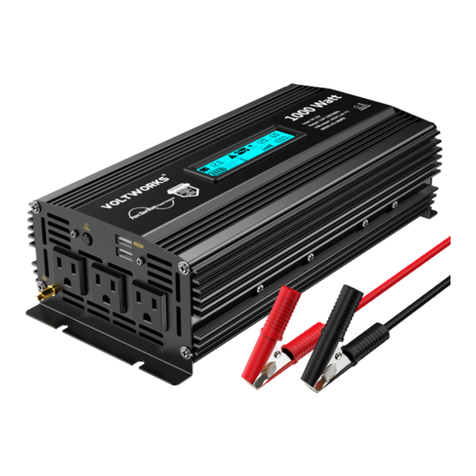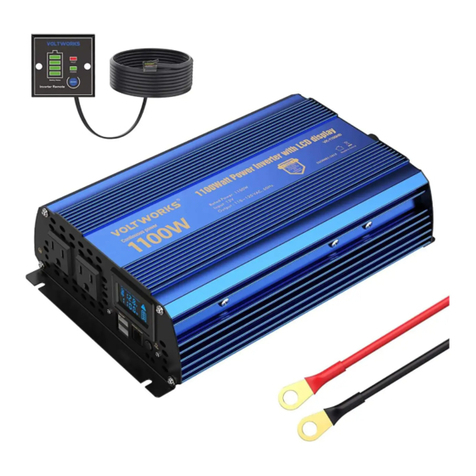
Battery Status
FAULT
POWER
ON/OFF
85mm
4.5mm
4. 5.
D. INVERTER INSTALLATION
Ensure there is enough space for the installation, and the location should be meet the
following requirements:
1. Water should not accessthe inverter.
2. The ambient temperature should be 32~104°F, and the preferred temperature is 50-
77°F. The lower the better inthis range of ambient temperature.
3. Do not mount the inverterupside down.
4. Allow 12 inches of space around the inverter to prevent objects from blocking the vents
and to provide enough air to circulate.
5. Do not install the inverter in an environment with high dust, saw dust residue or other
particles that may get sucked into the inverter increasing internal temperature.
6. There will be some electricalarcing or spark when the inverter connectswith the battery.
Combustible materials such as gasoline, alcohol, etc. should not be around the inverter.
7. We recommend mounting the inverter on something stable to prevent it from bouncing.
Impact shock could result in damage to your unit. Be sure to use all four mounting
screws for optimal stability. Mount in a location that can support the weight of the
inverter.
E. REMOTE CONTROLLER INSTALLATION
1) Fix the remote box on flat surface where a hole should be made, and use 2 screws to fix
it through the two mounting holes on the remote controller.
2) Or fix the remote on astandard 86X86mm(3.39x3.39 inch) power socket;
3) Connect the inverter and remote controller by wire before mounting.
Remark: Without remote controller, you can turn on the inverter by the switch on the
inverter too.
F. BATTERY
1. The battery is designed to supply the inverter with DC input voltage and the rated
voltage should be in accordance with the rated input voltage of the inverter. Any voltage
exceeding the range of the input voltageof the inverter will cause the inverterto go into
overload and could possibly damage the inverter. The battery should supply enough
current for the load. The load is the amp or watt rating of the equipment being powered
by the inverter. A small capacity battery cannot provide enough power for a large
electrical equipment. In this case, the battery will cause the inverter to go into under
voltage protection because of the load put on the battery. A simple way to calculate the
load or amps required from your battery is to divide watts of equipment by battery
voltage.
Due to the consumption of the inverter itself, the actual current will be about 10%. For
example, the voltage of lead acid battery is 12VDC, and load of the equipment is
1000W, therefore, the actual current needed from the battery is about 1000W / 12V =
83.3 amps per hour. Add 10% for efficiency loss and you get 83.3 * 1.10% = 91.6 amp
per hour needed. If you don't know the wattage of your equipment, you can figure the
wattage by multiplying AC amps by AC voltage. For example, a refrigerator is 8 AC
amps * 120 Volts AC = 960 watts. Remember, all equipment has a start-up requirement
3-5x its running wattage. In this example, 960 watts * 3 = 2880 watts needed from the
inverter so don't size your inverter too small.
2. Battery operating time depends on battery capacity and load. The formula for
operating time is: battery capacity divided by the value of the load divided by battery
voltage times 1.10%. For example, using the numbers from above, the battery
specification is 12V, 200Ah capacity and the load is 1000W. Take battery capacity
200Ah / 91.6 amps = 2.18 hours of run time if you fully deplete the battery. This is NOT
recommended. Deep cycle batteries last longer when they are only depleted to 50% of
capacity.
G. CONNECTION
1. Grounding
The power inverter has a terminal on the rear panel marked " Grounding "or " ". This
is used to connect the chassis of the power inverter to ground. The ground terminal has
already been connected to the ground wire of the AC output receptacle through the
inverter.
The ground terminal must be connected to the ground wire, which will vary depending
on where the power inverter is installed. In a vehicle, connect the ground terminal to the
chassis of the vehicle. In a boat, connect it to the boat's ground system. In a fixed
location, connect the ground terminal to earth.
2
The ground wire must be 14AWG(2.08mm )or larger,and make sure the connections
are well.
2. Battery Connection:
Before you connect the battery cables, make sure the power switch is in the off position.
Connect Red (+) battery cable to Red(+) inverter terminal. Connect Black (-) battery
1 26




























